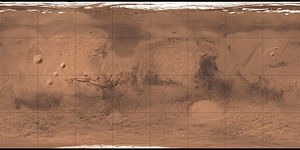Arsia Mons
| Volcano on mars | ||
|---|---|---|
| Arsia Mons | ||

|
||
|
|
||
| position | 9 ° 13 ′ S , 120 ° 23 ′ W | |
| expansion | 350 km | |
| height | 14,000 m | |
Coordinates: 9 ° 13 ' S , 120 ° 23' W The Arsia Mons is a shield volcano in the Tharsis region of the planet Mars one of the three and Tharsis Montes , the first time in 1971 from the spacecraft Mariner were observed. 9 With a base diameter of 350 km and an altitude of 14 km, it is the second largest known volcano by volume. The air pressure on the summit is below 107 Pascal . The volcano is the starting point for a water ice cloud that forms repeatedly every Mars year and lasts for about 80 days or more.
Like the entire chain of the Tharsis Montes, the Arsia Mons has been extinct for around 100 million years. The unusual size of these shield volcanoes is probably due to the fact that there are no plate tectonics on Mars ; so the crust does not pull over the hotspot . Instead of a chain of volcanoes, a huge shield volcano is created. The strong past volcanic activity may have been caused by an impact event - possibly the same one that formed the vast Hellas Planitia basin on the opposite side of the planet .
The wide caldera , which was created when the emptied magma chamber collapsed , has a diameter of 110 km and annually provides space for cyclonic dust storms, which are caused by warm air that rises on the flanks of the mountain in the southern Martian hemisphere before winter begins Carries dust particles with it. The spiral cloud towering over the caldera can reach heights of 15 to 30 km - a phenomenon that cannot be observed in the other volcanoes in the Tharsis region.
The flanks of the Arsia Mons are also characterized by large-scale collapse structures, especially along a weak zone that runs through the volcanic cone from north to south. These collapse funnels, up to 2 km deep, were probably formed as extensive lava flows that initially only hardened on the surface, while the molten rock continued to flow in the cavity below. Later, the resulting cavities collapsed. In 2007 the space probes 2001 Mars Odyssey and Mars Reconnaissance Orbiter discovered other geological structures - the so-called Seven Sisters on the slopes of the volcano. These dark spots with a diameter of 100–250 m are interpreted as cave entrances. Whether these are just vertical chimneys or accesses to extensive cavities, however, must remain speculation for the time being. Hopes that primitive ecosystems could have developed in the caves can be classified as unrealistic because of the extreme high-altitude climate.
See also
Web links
- Arsia Mons at the FU Berlin
- Arsia Mons at Malin Space Science Systems
- Close-up of a hole in Mars - Astronomy Picture of the Day from September 28, 2007.
- DLR : Lava flows from the Arsia Mons volcano in Daedalia Planum , October 9, 2009
- DLR: Lava flows at the foot of the Mistretta crater on Mars March 6, 2014
Individual evidence
- ↑ Arsia Mons in the Gazetteer of Planetary Nomenclature of the IAU (WGPSN) / USGS
- ↑ Brooks Hays: Mars orbiter spots return of long, thin cloud on Red Planet. In: marsdaily.com. July 30, 2020, accessed on August 6, 2020 .
